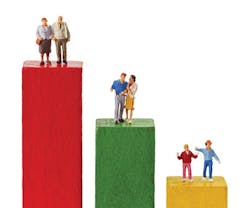Designing from the Inside Out
Approaching a project with an inside-out perspective demands cognizance of a multiplicity of needs—spatial, technical, cultural, and functional. The interior evolves as each of these concerns is defined and integrated into a holistic solution. Also central to a successful outcome is recognizing and incorporating larger, critical concepts such as sustainability and resiliency from the start, versus addressing them later.
Has this made our job as designers more difficult? Yes, our role is more complex, but in many ways it is also filled with greater opportunity. We are now required to embrace skills beyond planning, creative, and execution. We must seek and understand demographic and psychographic trends. What is driving urban/rural migration? What shifts are occurring due to the tsunami-like influence of millennials and aging boomers?
The U.S. Census Bureau tells us our elderly population will more than double by the year 2050, growing to some 80 million. Roughly one in five U.S. adults will be over the age of 65. While generations born after 1980 have driven demand for apartments in recent years, aging generations will be the next wave, pushing up rents and spurring construction of more multifamily housing. Aging in place is the growing preference with this group, which is already making an impact. One of our greatest challenges as designers will be how to meet the demand for quality living/working environments for a rapidly growing population of older adults.
It’s not only about residential living challenges, but how we will accommodate their needs across every sector of the interior environment—private, commercial, and public. From hospitality to workplace and healthcare to retail, the demand for innovative multi-disciplinary solutions is formidable. Principles such as universal design and design for longevity give designers the skills and knowledge to address these needs. And who is more uniquely qualified to create supportive, responsive environments that are functional, healthy, and safe than we, as designers?
The opportunities exist at the lower end of the age spectrum as well. Look no further than the millennials—that often discussed group that is raising the bar by how they access design services and information, and what they want when they get there. They have a unique perspective on life and how it should be lived, something that is without question reshaping space design and development. At ASID, we’re not only studying these trends, we’re shaping them and the generation with initiatives like GoPro, Design to Lead, and this month’s Student Summit.
And, as you well know, there are other significant considerations. What do sociologists and healthcare experts tell us about our interior spaces that impact productivity and well-being? What principles must we rethink to create truly life-changing environments?
As Dr. Wayne Ruga, founder and president at the CARITAS Project, noted, “We provide a service for our clients, for building owners, for people who make decisions about how our environment gets designed and built. And I believe that we have a professional obligation to sit down with the people who will be the users and understand, from the perspective of their experience, how we can design this in a way that is not only meaningful, but can really support them in having a life that they dream that they would like to have.”
At the same time, it’s often an iterative process. “In generative space design, there is no end to the project,” added Ruga. “It is a continual, learning, and improvement experience, because as we complete the project and people begin to use it, it’s very useful to go back and ask how it is working and whether we can make further adjustments, based on experience.”
It can be daunting. But in many ways, we are among the most suited in our industry to coalesce the disciplines required to address these challenges by serving as conveners and conductors. As Terese Wilson, partner at LSM in Washington, D.C., observed in a recent ICON article, “Designers or architects can’t be the sole knowledge-holders of everything. Our role is to understand who can bring that level of expertise to the table.” She observes that designers are, in essence, becoming the quarterbacks of design projects. They lead the charge and coordinate the efforts.
That certainly takes design expertise, but also leadership to recognize and utilize the strengths of many individuals to gain a coordinated, impactful outcome. “Interior design is taking an interdisciplinary approach to create better spaces and meet client demands and, in the process, the designer often is the maestro of a finely orchestrated plan that pushes well beyond the traditional world of interiors,” noted a recent story in ICON.
In my travels over the past months, I’ve met with ASID chapters and industry leaders, and it’s abundantly clear that our industry is changing rapidly. Designing from the inside out brings with it an exciting new chapter in our development as practitioners and firms—one that we are capable of embracing together.
Sandy Gordon, FASID, LEED AP, is the chair of the board of directors for ASID and principal of SGI Interiors in Madison, Wisc. Learn more about ASID at ASID.org.
